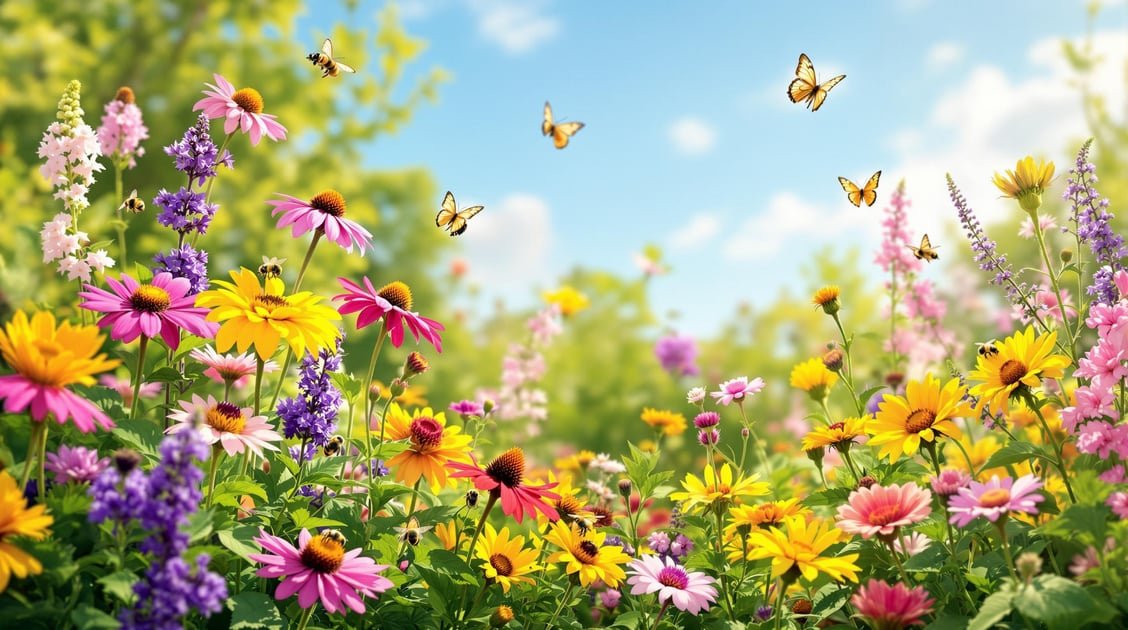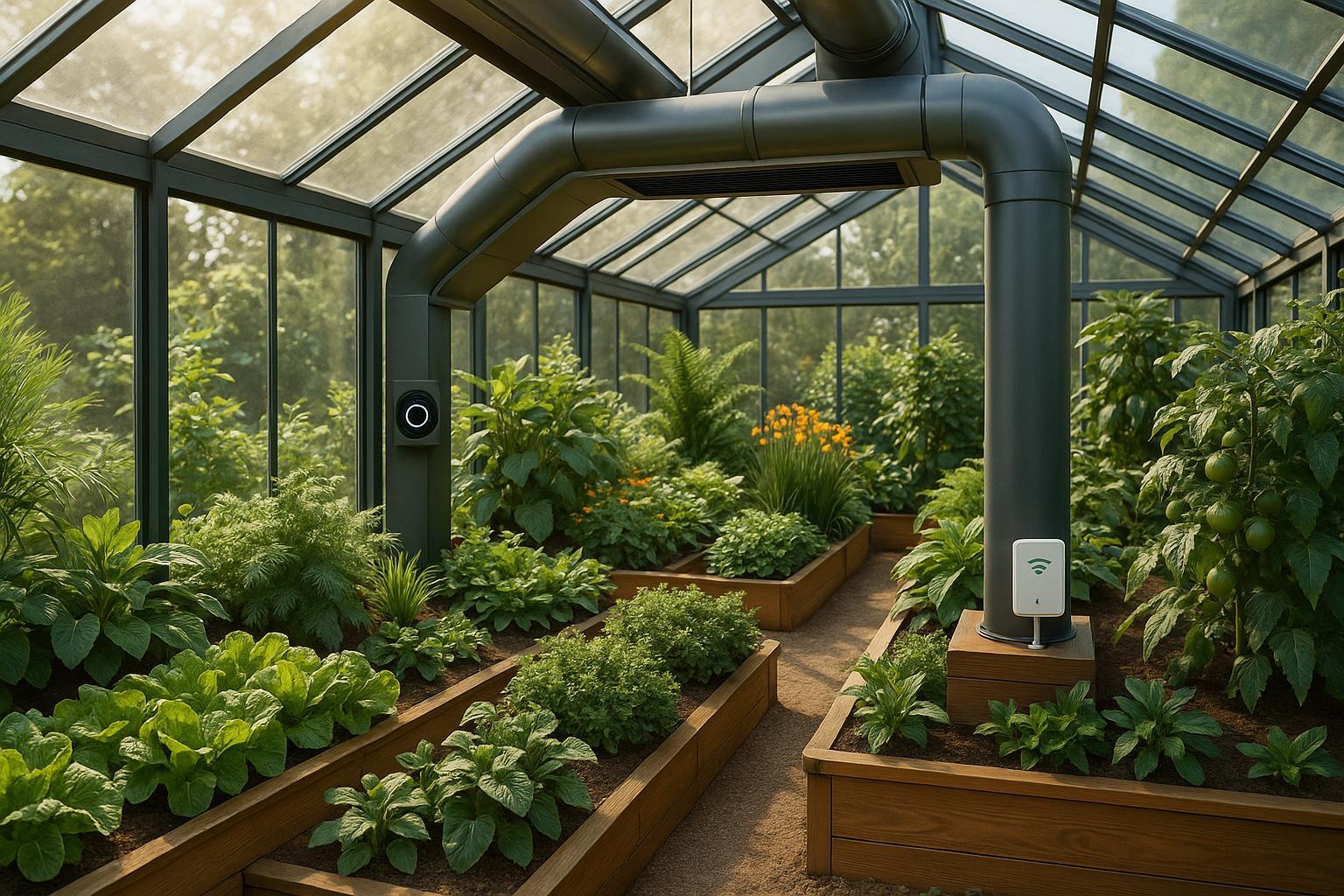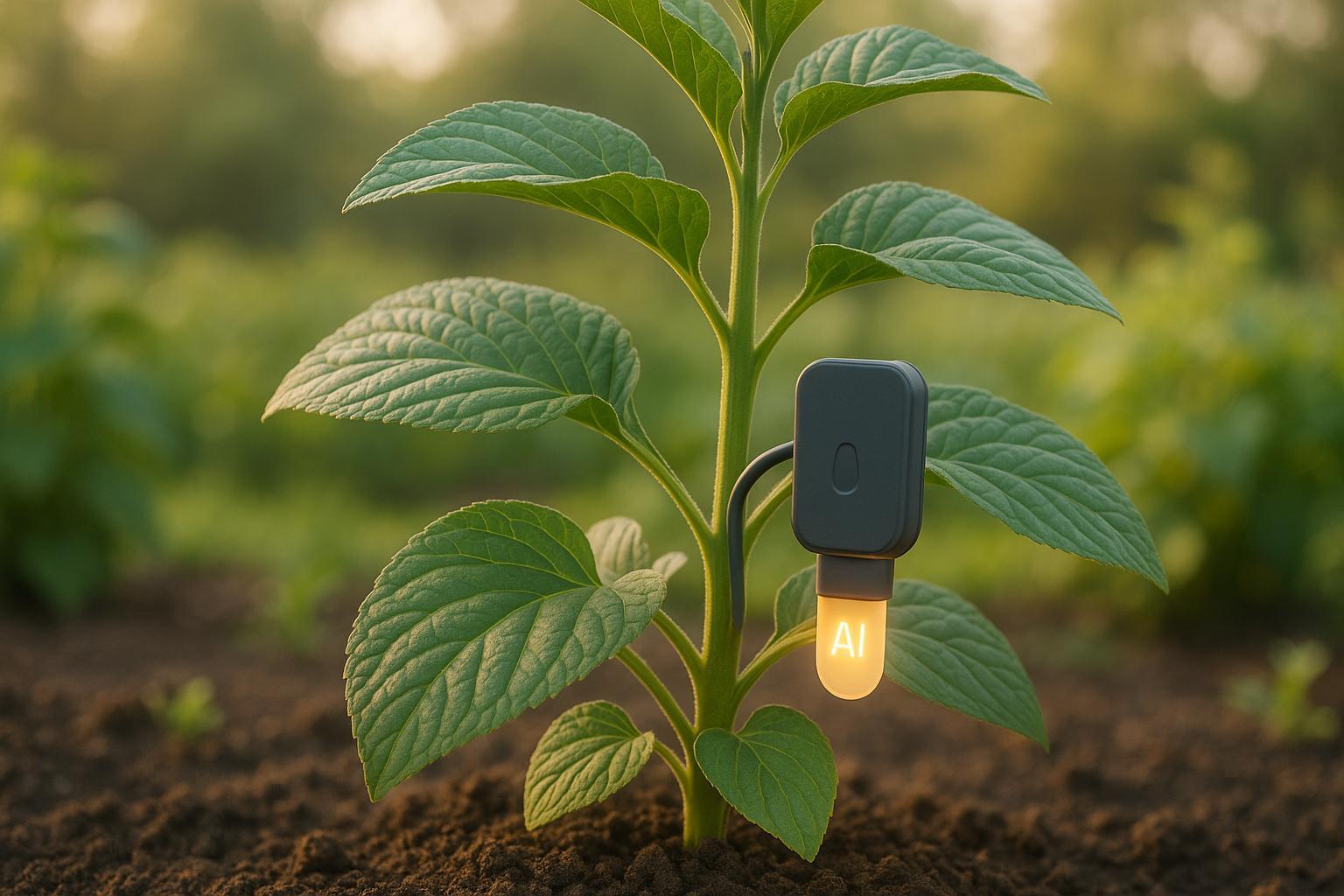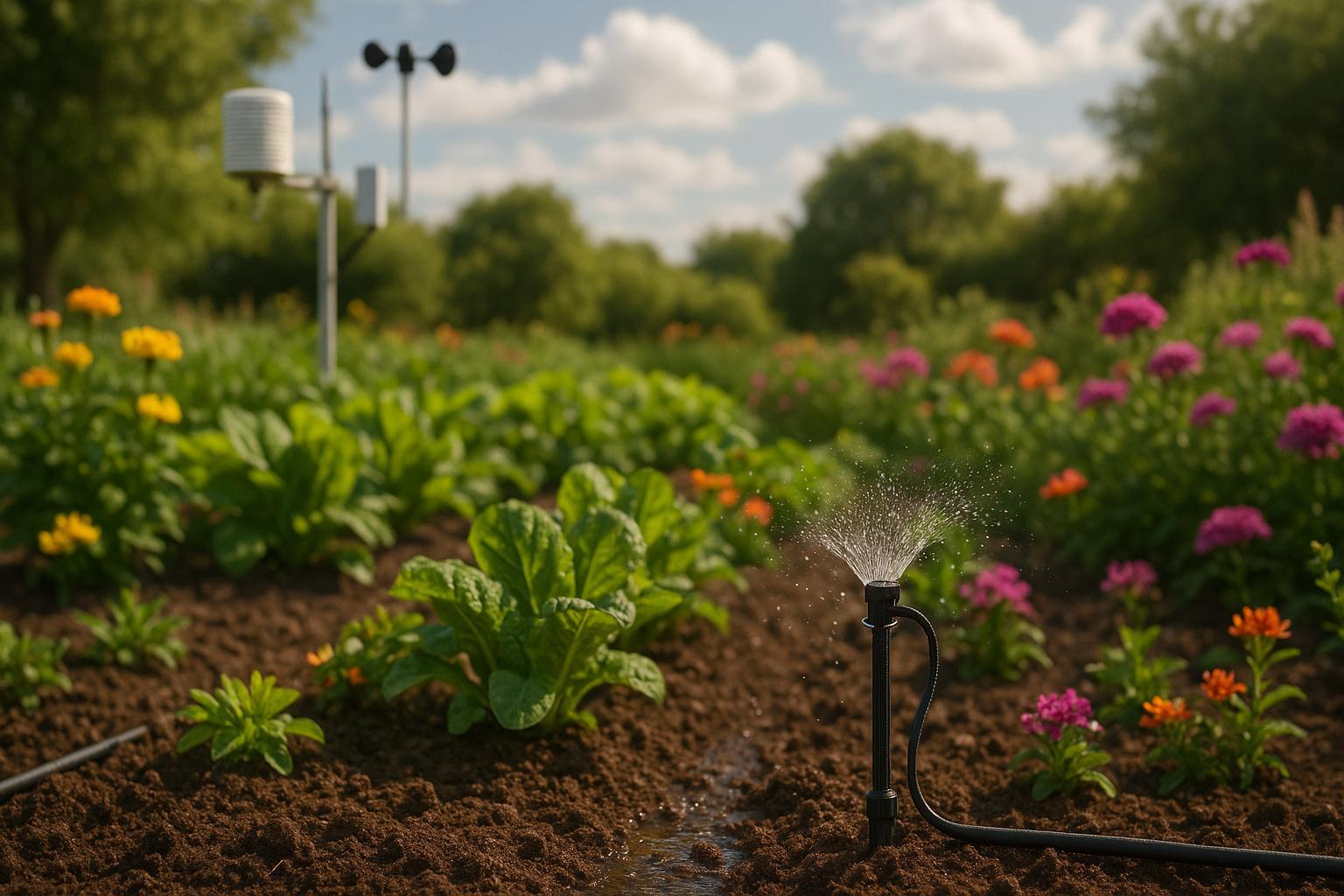Best Plants for Pollinators by Climate Zone

Want to attract pollinators to your garden? Start by choosing the right plants for your climate. Whether you live in a cold, temperate, or warm zone, this guide has you covered with specific plant recommendations, care tips, and pollinator insights.
Quick Overview by Climate Zone:
- Cold Climates (Zones 3-5): Hardy perennials like Purple Coneflower and Butterfly Weed thrive in short growing seasons and attract bees, butterflies, and birds.
- Temperate Climates (Zones 6-8): Vibrant options like Bee Balm and Joe Pye Weed bloom from spring to fall, drawing hummingbirds and butterflies.
- Warm Climates (Zones 9-11): Year-round blooms from plants like Butterfly Bush and Firebush provide nectar for hummingbirds and butterflies.
Quick Comparison Table:
| Climate Zone | Best Plants | Primary Pollinators | Bloom Period |
|---|---|---|---|
| Cold (3-5) | Purple Coneflower, Butterfly Weed | Bees, Butterflies, Birds | Summer |
| Temperate (6-8) | Bee Balm, Joe Pye Weed | Hummingbirds, Butterflies | Spring to Fall |
| Warm (9-11) | Butterfly Bush, Firebush | Hummingbirds, Butterflies | Year-Round |
Tip: Native plants are your best bet - they’re adapted to your local conditions and naturally attract local pollinators. Read on for detailed plant suggestions and maintenance tips tailored to your zone.
1. Cold Climate Plants (Zones 3-5)
Recommended Plants
In cold climate zones, plants need to handle harsh winters and short growing seasons. Here are some hardy native perennials that thrive in these conditions while also supporting local pollinators:
- Purple Coneflower (Echinacea purpurea): Blooms from June to October, grows 2-4 feet tall.
- Wild Bergamot (Monarda fistulosa): Flowers from July to September.
- New England Aster (Symphyotrichum novae-angliae): A late-season bloomer with vibrant purple flowers.
- Butterfly Weed (Asclepias tuberosa): Produces bright orange flower clusters from June to August.
- Black-Eyed Susan (Rudbeckia hirta): Displays golden-yellow petals from June to September.
Pollinators Attracted
These plants are a magnet for various insects and birds. Here's a quick look at who they attract and when:
| Plant Name | Primary Pollinators | Peak Attraction Period |
|---|---|---|
| Purple Coneflower | Bees, Butterflies | Mid-Summer |
| Wild Bergamot | Hummingbirds, Bees | Late Summer |
| New England Aster | Monarch Butterflies | Fall |
| Butterfly Weed | Butterflies, Native Bees | Early Summer |
| Black-Eyed Susan | Small Bees, Beetles | Mid-Summer |
How These Plants Survive Cold Climates
These plants are built to handle the challenges of cold regions through:
- Deep root systems: These roots extend below the frost line, ensuring stability and access to nutrients.
- Dormancy: During winter, vital tissues are protected as the plants go dormant.
- Early growth: They emerge quickly in spring, making the most of the short growing season.
Maintenance Tips
To keep these plants healthy, follow these care guidelines:
- Water weekly with about 1 inch during the growing season.
- Use well-draining soil enriched with organic matter.
- Prune dead foliage in spring to encourage new growth.
- Divide plants every 3-4 years to prevent overcrowding.
- Leave seed heads intact in winter to provide food for birds.
For personalized care schedules, tools like AIGardenPlanner can help tailor maintenance to your specific garden conditions. These practices ensure your plants thrive and can be compared with options suited for other climate zones.
Up next: plant selections for temperate climates.
2. Temperate Climate Plants (Zones 6-8)
Suggested Plants
Temperate zones are home to a variety of vibrant, pollinator-friendly plants, including:
- Bee Balm (Monarda didyma): Grows 2–4 ft tall; features red blooms from July to September.
- Blazing Star (Liatris spicata): Reaches 3–5 ft in height; displays purple spikes in July and August.
- Joe Pye Weed (Eutrochium purpureum): Stands 5–7 ft tall with mauve flower clusters.
- Anise Hyssop (Agastache foeniculum): Produces blue-purple spikes from June to September.
- Cardinal Flower (Lobelia cardinalis): Grows 3–4 ft tall; showcases red blooms from July to September.
Pollinators These Plants Attract
Plants in temperate climates attract a range of pollinators throughout the year. Here's a breakdown:
| Plant Name | Main Pollinators | Peak Pollinator Season |
|---|---|---|
| Bee Balm | Hummingbirds, Butterflies | Mid-Summer |
| Blazing Star | Monarch Butterflies, Bees | Late Summer |
| Joe Pye Weed | Swallowtail Butterflies | Late Summer to Fall |
| Anise Hyssop | Native Bees, Honeybees | Summer through Fall |
| Cardinal Flower | Hummingbirds | Mid to Late Summer |
Adapting to the Climate
Plants thriving in temperate zones have several built-in features to handle the environment:
- Tolerate freezing temperatures as low as –10°F.
- Flexible bloom times that adjust with seasonal shifts.
- Root systems designed to manage changes in moisture levels.
- A lifecycle that includes winter dormancy to endure colder months.
Care and Maintenance
To keep these plants healthy, follow these seasonal care tips:
- Spring (March–May): Clear away dead foliage and spread 2–3 inches of organic mulch.
- Summer (June–August): Provide 1–1.5 inches of water weekly.
- Fall (September–November): Trim back faded blooms and leave seed heads for birds.
- Winter (December–February): Add a layer of winter mulch after the ground freezes.
For optimal growth, plant them in well-draining soil mixed with organic material and ensure they receive 6–8 hours of direct sunlight daily.
Up next, learn about plant options for warmer climates.
3. Warm Climate Plants (Zones 9-11)
Recommended Plants
Warm climate zones, with their mild winters and long growing seasons, are ideal for a variety of pollinator-friendly plants. Here are some top picks:
- Butterfly Bush (Buddleja davidii): A 6–12 ft tall shrub featuring fragrant clusters of purple, pink, or white flowers.
- Mexican Sunflower (Tithonia rotundifolia): Grows 4–6 ft tall and produces striking orange blooms.
- Firebush (Hamelia patens): An evergreen shrub reaching 8–15 ft, known for its tubular red-orange flowers.
- Coral Honeysuckle (Lonicera sempervirens): A climbing vine with trumpet-shaped red flowers.
- Blue Porter Weed (Stachytarpheta jamaicensis): A compact 2–3 ft tall shrub with purple-blue flower spikes.
Pollinators Attracted
These plants are a magnet for butterflies, hummingbirds, and native bees, providing food and habitat throughout the year:
| Plant Name | Primary Pollinators | Active Season |
|---|---|---|
| Butterfly Bush | Monarch and Swallowtail butterflies | Spring through Fall |
| Mexican Sunflower | Bees, butterflies, and hummingbirds | Summer through Fall |
| Firebush | Ruby-throated hummingbirds | Year-round |
| Coral Honeysuckle | Hummingbirds and native bees | Spring through Fall |
| Blue Porter Weed | Gulf fritillary butterflies | Year-round |
Climate Adaptations
Plants in zones 9–11 have developed traits that help them flourish in warm climates:
- Deep root systems: Help access water during dry periods.
- Waxy leaves: Reduce water loss.
- Heat-resistant flowers: Handle intense sunlight.
- Drought tolerance: Ensures survival during prolonged dry spells.
These natural features make them resilient but still require specific care to thrive.
Maintenance Needs
Keeping these plants healthy in warm climates involves tailoring care to local conditions. Since they face intense heat and occasional drought, follow these tips:
- Water deeply during the summer, fertilize periodically, and prune as needed.
- Use mulch to retain moisture and regulate soil temperature.
With proper care, these plants will continue to support pollinators and enhance your garden.
sbb-itb-4d6a8dd
🚀 Ready to Reinvent Your Garden?
Join thousands of homeowners who have transformed their gardens using our AI design tool. Upload one photo to explore endless possibilities.
Get your AI garden designs →Pollinator Garden Guide | P. Allen Smith: Bloom With Us


Plant Comparison Guide
To support pollinators effectively, it's important to choose plants that thrive in your specific climate. This guide breaks down how plants perform across various climates.
Growth and Maintenance Comparison
| Feature | Cold Climate Plants (Zones 3-5) | Temperate Climate Plants (Zones 6-8) | Warm Climate Plants (Zones 9-11) |
|---|---|---|---|
| Bloom Period | Summer blooms, shorter display | Blooms from mid-spring to early fall | Blooms nearly year-round |
| Water Needs | Moderate watering | Needs consistent moisture | Frequent watering in summer |
| Sun Exposure | Full sun, afternoon shade | Full sun | Full sun, afternoon protection |
| Winter Protection | Significant protection needed | Moderate protection | Minimal care |
| Growth Rate | Slow to moderate | Moderate to fast | Rapid |
Pollinator Attraction Comparison
| Climate Zone | Primary Pollinators | Peak Activity Season | Nectar Levels |
|---|---|---|---|
| Cold (Zones 3-5) | Native bees, bumblebees | Summer | Moderate |
| Temperate (Zones 6-8) | Honeybees, butterflies, moths | Spring through fall | High |
| Warm (Zones 9-11) | Hummingbirds, butterflies, bees | Extended period | Abundant |
Care routines and pollinator attraction vary widely depending on the climate.
Maintenance Requirements by Zone
-
Cold Climate (Zones 3-5)
Seasonal tasks include heavy mulching for winter, strategic deadheading during the short growing season, and thorough cleanup before winter. -
Temperate Climate (Zones 6-8)
Maintenance is steady throughout the growing season, with moderate winter protection and occasional division of perennials. -
Warm Climate (Zones 9-11)
Plants require year-round pruning, monitoring for heat stress, and minimal preparation for winter.
Success Factors
| Success Factor | Cold Zones | Temperate Zones | Warm Zones |
|---|---|---|---|
| Soil pH Preference | Neutral to slightly acidic | Moderate range | Wide range |
| Annual Rainfall | Moderate needs | Moderate to high | High or irrigated |
| Growing Season | Short | Moderate | Extended |
| Frost Tolerance | High | Moderate | Low |
| Heat Tolerance | Limited | Moderate | High |
This guide helps you select plants that align with your climate while supporting pollinator activity and maintaining manageable care routines.
Using AIGardenPlanner for Plant Selection

Create a thriving pollinator garden by choosing plants that suit your local climate. AIGardenPlanner uses AI to recommend species tailored specifically to your area.
Climate-Based Plant Suggestions
The AI Plant Advisor evaluates your location and climate zone to provide personalized plant recommendations that support local pollinators. It takes into account several key factors:
| Factor | What It Does |
|---|---|
| Location Data | Identifies your USDA hardiness zone |
| Growing Conditions | Considers sunlight, soil type, and moisture levels |
| Pollinator Support | Matches plants to pollinators native to your area |
| Maintenance Needs | Suggests plants suited to your gardening experience |
Tailored Garden Planning
AIGardenPlanner offers tools to help you design a garden that fits your needs and style:
- Photo-Based Design: Upload a photo of your garden, and the AI will suggest designs featuring climate-friendly pollinator plants.
- Style Selection: Choose from over 50 garden styles, including layouts focused on attracting pollinators.
- Growing Guides: Get detailed care instructions for every plant in your plan.
These features work together to help you create a garden that’s both functional and beautiful.
Advanced Tools and Subscription Options
For those looking to take their pollinator garden to the next level, AIGardenPlanner offers a range of subscription plans with professional tools:
| Plan | Features for Pollinator Gardens |
|---|---|
| Pay As You Go ($15) | Basic AI Plant Advisor access and up to 15 design generations |
| Starter ($19/month) | 50 designs per month and custom style options |
| Pro ($49/month) | 200 designs monthly, commercial license, and priority support |
| Premium ($99/month) | 500 designs monthly and management for up to 1,000 projects |
Simplified Maintenance Planning
Keeping your garden healthy is easy with AIGardenPlanner’s maintenance tools. Each plant recommendation includes care schedules tailored to your climate, covering:
- Watering needs
- Pruning and deadheading timelines
- Seasonal care tips
- Peak pollinator activity periods
Monitor your garden’s progress and prepare for the next growing season with ease.
Summary and Next Steps
Building a successful pollinator garden starts with selecting plants that thrive in your specific climate. With the plant suggestions provided, here’s how to move forward with your garden project.
Steps to Get Started:
- Assess: Upload a photo of your garden to AIGardenPlanner to receive tailored plant suggestions.
- Plan: Use insights from AIGardenPlanner to create a strategy based on your climate and maintenance preferences.
-
Implement: Follow growing guides to schedule key activities:
- Planting spring bulbs
- Establishing summer perennials
- Preparing your garden in the fall
- Protecting plants during winter
Tips for Success
Aim to support pollinators year-round by including plants that bloom at different times of the year. If you’re new to this, consider starting small and expanding as you gain confidence with your plant choices.
AIGardenPlanner’s tools can help you:
- Track plant growth and monitor pollinator activity
- Adjust your care routine as needed
- Keep a record of successful plant combinations
🎨 Visualize Your Dream Garden Today!
Transform any outdoor space into a professional landscape design in minutes. Just upload a photo, choose your style, and let our AI do the rest.
Start your garden transformation now →Related posts
Related Articles

AI-Powered Ventilation for Climate-Specific Gardens
AI-powered ventilation systems optimize garden climates with real-time data and smart technology, enhancing plant health and energy efficiency.

AI Sensors for Perennial Plant Stress Detection
Explore how AI sensors are revolutionizing perennial plant care by detecting stress early and optimizing water management for sustainable gardening.

AI Tools for Designing Vertical Plant Combinations
AI tools streamline vertical garden design by optimizing plant selection, layout, and maintenance, making gardening accessible for everyone.

5 Machine Learning Models for Frost Forecasting
Explore five machine learning models for accurate frost forecasting, helping protect crops and optimize planting schedules.

AI Tools for Seasonal Irrigation Forecasting
AI irrigation systems optimize water use and plant care by analyzing weather and soil conditions, ensuring healthier gardens and cost savings.

Mastering Garden Planning: A Comprehensive Guide for Every Gardener
Discover essential garden planning techniques, from selecting the perfect location to choosing the right plants and maintaining your garden. Ideal for both beginners and experienced gardeners!